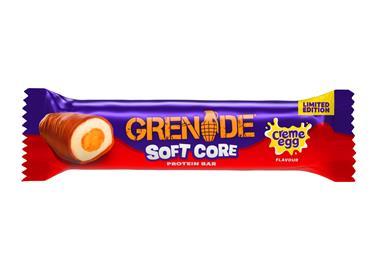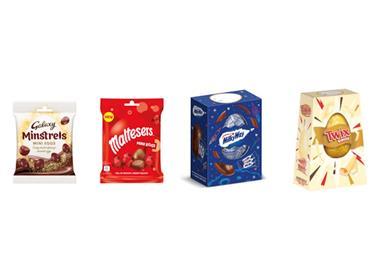Chocolate remains a hugely important category for c-store owners, yet many retailers have been left craving better sales from singles
There’s no denying the UK confectionery market is huge, worth more than £5.3bn (Nielsen, Total Value MAT to w/e 29 October 16) and it is the most impulsive category available to convenience stores (Nielsen all categories GB MAT July 2012). As such, retailers are well aware of the importance of the category.
“I don’t imagine there’s a c-store retailer out there who wouldn’t say chocolate is an important category for them,” says Colin Smith, manager of Pinkie Farm Nisa Local in Musselburgh, East Lothian, adding: “It’s a very important part of our offering.”
However, chocolate has seen a sales decline of 0.6% over the past year (IRI) and what’s worse, this decline is happening within the convenience sector, not the supermarkets.
Interestingly, across all channels the number of units declined faster than volume, meaning customers have been choosing larger pack sizes as they search for value (IRI Marketplace). Their quest for value is understandable as the cost of cocoa has been rising for years due to inflation, falling production and increased demand worldwide. According to mysupermarket.com, prices of popular chocolate bars have increased by up to 13% in the past year alone.
Gregory Cochrane, who runs Eurospar Binnian Fresh Foods and Fresh Food Centre in Kilkeel, County Down, says chocolate is a “massive part” of his business, but he has noticed that sales in the category seems to have “flatlined” overall and he puts this down to a reduction in impulse bar sales.
“I think the reason for this is people’s heightened awareness of health. I’m noticing more people picking up a piece of fruit or a cereal bar instead of a chocolate bar,” he explains.
Susie Hawkins, who runs stores under the Simon Smith Group in Gloucestershire, agrees that chocolate is an “incredibly important” category and while multipacks are doing very well, impulse chocolate is now increasingly being dismissed and replaced by healthier options.
Dee Sedani, who runs a One Stop store in Etwall, Derby, says the degree to which shoppers will choose healthy products over chocolate will depend on the location of the store.
“A store in central London might tell you they sell way more healthy cereal bars than chocolate bars, whereas elsewhere you’ll have a completely different trend, so the health element has a very different effect in every store.”
David Heritage, owner of the Barns Green Village Store, in Barns Green, West Sussex, says £1 big tablet bars are becoming more popular than single impulse bars now as customers see them as much better value for money.
“The bars are meant for sharing, but I don’t think people are sharing them. They are picking them up for £1 instead of the single bars for 65p. The best-selling brands within the tablets fixture are Cadbury Dairy Milk, Galaxy and Aero Mint.
“I now devote the whole top shelf of that category to tablets. It’s a tough fixture to merchandise because each bar takes up quite a lot of space so when new variants come out it’s hard to choose which to include.”
David is right that £1 blocks tend to be popular. Mars says sharing blocks have grown by 2% across the category (Nielsen w/e 31 December 2016). Galaxy, the number two chocolate brand in the UK, is well equipped to thrive in this area with a strong large block and bitesize portfolio and £218m in sales and growth of 1.3%. This was driven by the launch of Galaxy Crispy and Salted Caramel.
Hancocks says it, too, is continuing to see strong growth in blocks and variety packs in the convenience channel thanks to the increasingly popular sharing trend. The firm says that this, coupled with the “round pound” trend, sees £1 blocks growing ahead of traditional countlines, which are currently in decline.
Val Packham, store manager of Handcross Post Office and Stores in West Sussex, is noticing people choosing packs that give them value for their money, except her customers are opting for double bars as opposed to tablets. She says this is partly driven by the fact that impulse single bars have got smaller over the years. She says her shoppers are clearly aware of the best way to get value for money.
“The singles bars are shrinking in size so people are seeing those as poor value for money. You can buy a single at 60-70p, or a double at 99p. Instead, they are choosing to buy when the doubles are on promotion at three for two; they absolutely fly off the shelves.”
Gregory believes multipacks of chocolate are the category’s main strength. “I’m noticing more shoppers looking for value in the category. Even when they might have the chance to pick up a chocolate bar with a coffee-to-go they will come to the confectionery aisle to pick up a multipack instead in order to get value for their money. I would say about 30% of chocolate sales are multipacks now.”
Statistics back this up, as chocolate adult multipack sales have increased by 2.3% in the convenience channel, according to IRI Convenience MAT to 1 January 2017.
This trend away from single impulse bars makes smart merchandising all the more important, Gregory believes. “It means we have to think about the category more rather than just putting out the products on the shelves and expecting them to sell; we have to think what multi-deals we can offer, such as three for two on Cadbury Creme Eggs.”
Merchandising
Top tips from Mondelez International
Focus on the best-selling lines
Have a range that covers all need states: self-treats, sharing and gifting confectionery
Place best-sellers in the best-selling area, at the central point of vision
Use manufacturers’ POS material
Make the most of brand investment - have displays in store when consumers will be most aware of products as a result of advertising or media investment
Don’t forget the basics; keep fully stocked and keep the display tidy
Group products with similar attributes adjacent to each other (eg ‘containing nuts’)
Merchandising
Barrie Seymour, who runs a Londis store in Liversedge, West Yorkshire, says retailers have to keep up with the promotions and push these hard using the POS available to get the most out of the category.
“It’s a very promotion-driven category and when things are on promotion they really do fly out. You have to pile them up high and really push them.
“A sharing bag at £2.19 won’t really sell, but a sharing bag on promotion at £1 will sell by the case load. I buy 50 cases at a time when they’re on promotion – it’s phenomenal.”
Susan Nash, trade communications manager at Mondelez International, says: “While some consumers will visit your store specifically to purchase confectionery, many will decide to purchase a sweet treat while in your store. This makes display and category management advice a vital tool.
“Confectionery is produced in several formats covering self-eat products (often referred to as singles), sharing bags, gifts and seasonal products, making it a challenging category for any retailer. Displaying these well is central to confectionery success in store, as this can be key to driving additional purchases in your store.”
The many different packs formats available and different opportunities to encourage shoppers to purchase throughout their shopping journey make it a tough category to merchandise, says David. “If we take Maltesers, we have a 75g bag at £1, a 58.5g bag at 90p and a 37g bag at 70p. I always have chocolate in at least three areas of the store; within the confectionery category, by the till and with the deli, plus we will often include chocolate in our seasonal displays.
“It’s also a very promotion-driven category and the promotions are constantly changing so we’re forever moving the different SKUs on and off gondola ends.”
But it’s worth the effort, points out Lionel Cashin, who owns The News Shop, in Market Weighton, Yorkshire. He says chocolate is a category which strongly benefits from smart merchandising and siting throughout the store.
“We have chocolate as you first walk in the store, in the first aisle, then a secondary siting elsewhere in the store, to catch the shopper’s eye later in their shopping journey, and finally on display units at the tills to get that extra impulse sale.
“People don’t tend to come in for chocolate. They come in for bread, or tobacco, or a newspaper, and so we have to encourage them to pick up chocolate as an afterthought.”
Jonathan Summerley, purchasing director at Hancocks Cash and Carry, says cross-merchandising and positioning stock around the store helps to encourage shoppers to think about items that they may not have been planning to buy.
“For example, boxed chocolates may be situated by flowers and block chocolate by baking items. It is also vital to make the most of seasonal opportunities when merchandising ranges, investing in strong POS which draws attention to relevant seasonal products helping to increase impulse purchases.”
Some good news for the category is that the big night in occasion is bigger than ever (Kantar WorldPanel, August 2016). According to Levi Boorer, customer development director at Ferrero, people are choosing big nights in due to the uncertainty that 2016 brought.
“Consumer confidence shifted in 2016. As we’ve entered a period of uncertainty people are pulling back on their spending and longstanding consumer trends are reversing. As a result, people are opting to entertain more at home.
“This trend helps grow sales of sharing formats of chocolate. The total sharing bags sector is worth about £1.1bn, making up 20% of total confectionery, and while sales in the category are flat, chocolate sharing is still enjoying growth.”
Barrie Seymour says sharing bags are the best-selling chocolate format in his store. One of his best-sellers is mini eggs, rrp £1. He has been selling these since mid-December and they’ve sold throughout the Christmas season, January diet season and through to Easter. One way he has encouraged this is by displaying them on clip strips throughout the store as well as in dump bins next to the tills.
Boorer says shoppers will purchase for the big night in occasion as part of their main shop as well as a last-minute, spontaneous purchase. He says the latter is experiencing the most significant growth, due to an increasing number of people purchasing for their evening on their way home from work (HIM May 2016). This gives retailers a huge opportunity to influence shopper behaviour in terms of what they are going to eat and drink that night.
Advice
Ferrero creates advice website for retailers
Five years on from the launch of its trade website, Ferrero has added a trade digital platform, www.yourperfectstore.co.uk.
The new website has been built with the help of retailer research and insight which identified confectionery as the category that retailers wanted the most help from suppliers, particularly in terms of category advice and NPD news (79%, Retailer Inner Cirkle).
When it comes to tools, it found retailers are looking for high-quality planograms and POS material to drive their businesses.
The new website - which is mobile-optimised for retailers who are on-the-go - features three key pillars, among other brand information, to help retailers. These are: Grow Your Sales; Know Your Shopper; and News and Insights.
Spanning tailored planograms, interactive ideal stock list gap analysis and an informative blog, the website aims to be a hub for convenience retailers, helping them to maximise the potential of their confectionery fixture.
Levi Boorer, Ferrero customer development director, states: “Everyone knows that digital is a part of everyday life and this applies to the retail landscape, too. The speed of evolution in this sector is fast, and we need to ensure we are listening to our customers’ needs and adapting our tools. From its first conception, our vision was to bring together our best-in-class executions and market-leading brands in the form of a digital platform, aiding retailers and setting best practice within the industry. The relationship between retail and digital is constantly evolving and it is vital for suppliers and retailers to stay at the forefront to drive the best business results.”
To support the launch, Ferrero is rebranding its trade Twitter presence with a new identity in line with the Your Perfect Store website. The retailer-focused channel also features a new @FerreroYPS handle.
Pouches
Mars has noticed consumers favouring pouches and has been driving this growth with seven of the top 10 bitesize lines (Nielsen Total Impulse 12 w/e 31 December 2016), including Maltesers, which is the UK’s top bitesize brand (Impulse Report Total Independents P3 2016).
M&Ms also provides an opportunity to capitalise on the sharing trend, having outperformed the chocolate category by recording more than £7m in sales (an increase of 9.2%, Nielsen Scantrack, 52 w/e 8 October 2016). This was driven by the launch of two limited-edition sharing packs last year; M&Ms Mix and the summer packs containing only green, yellow and blue chocolates.
In order to tap into the trend for big nights in, Ferrero is placing a big focus on its Raffaello brand this year with a £2.85m investment.
Boorer explains: “Raffaello is the perfect thoughtful gift for those special girls’ night in occasions and we’ll be promoting this through our creative TV campaign, video-on-demand and a mass sampling programme.”
Premium
Colin Smith says that premiumisation is a noticeable trend within the category. “Something I’ve noticed is that people seem to be happy to pay a bit more to get good quality chocolate. I’ve started selling more premium chocolates and bigger items. We got in two £50 Lindor Chocolate bunnies last Easter. They provide your store with a point of difference and they create interest.”
Boorer says Ferrero is seeing a continued trend towards premium confectionery products. He says when it’s a gift that shoppers are looking for, they will opt for quality over quantity. To this end, he recommends Thorntons as the best gift solution.
“Boxed chocolates provide a lucrative sales opportunity for retailers, particularly with shoppers trading up to more premium treats to share with loved ones during an evening at home. We’re championing those special moments enjoyed between family and friends with our latest Thorntons campaign. Thorntons returned to the nation’s TV screens on 11 November for the first time in six years with a £4.8m media campaign – ‘Pass the love on’.”
Val says Thorntons is the most popular brand of boxed chocolates in her store and suggests this is simply due to the good taste of the chocolates and the value for money offered. “When people are buying as gifts, that seems to be what they choose. The chocolate tastes really nice and they cost the same as the other brands.”
However, she has noticed an overall decline in the popularity of boxed chocolates. “I think whereas in the past someone might run in to grab a box of chocolates for their mum for Mother’s Day, now they want to go into town to get more than just chocolates. It’s the same with Valentine’s Day and even at Easter. I think people are buying more than just a box of chocolates.
“We mostly sell boxes when it’s a last-minute purchase such as when people are popping in on their way to a dinner party.”
The types of chocolates selling in a c-store could be influenced by the demographics of the area. According to HIM Research and Consulting (2016 CTP study), people at different life stages buy into different chocolate formats. The research shows that males aged 16-24 are most likely to buy impulse chocolate bars, shoppers over the age of 55 are most likely to buy big sharing blocks of chocolate and seasonal confectionery, and females are more likely than males to buy big blocks, sharing sized bags, boxes or tins and seasonal chocolates.
In line with this research, Val says the majority of big block buyers in her store are from the over-55s. What’s more, impulse bars are mostly bought by men, however her store is on the main route to the village so most of the impulse bars are picked up by passing tradesmen.
One store that sees a high footfall from students is Shelley’s Budgens, in Horsham, West Sussex. Owner Chris Shelley sees high sales of impulse chocolate in his store, as the store is near a primary school as well as the town’s main college.
“Chocolate is an important category for us. We are on a school run route so we get lots of kids in on their way to and from school. The most popular lines are the standard Kit Kat, Mars and Snickers. We have the Kit Kat Cookie Dough variant, which is also popular.”
The way people buy chocolate also varies depending on the time of year. Barrie Seymour says chocolate is especially popular through the colder months in his Londis store.
“Up in Yorkshire it gets very cold and dark and people just want to stay in and eat chocolate and drink wine. People don’t venture out in the evenings much at all during the week. In the summer months, they are much more likely to pick up sugar confectionery.”
As well as being affected by the temperature, chocolate sales soar in the run-up to special events. Colin Smith says: “The popularity of the different chocolate brands varies with the seasons. In the lead up to Mother’s Day we sell a lot of Cadbury Milk Tray and in the lead up to Valentine’s Day we sell a lot of Ferrero Rocher heart-shaped boxes.”
Lionel agrees that boxed chocolates are “terribly seasonal”, as well as being pretty much solely bought by men buying as a gift for their female partners. He says the top sellers in the chocolate category are the well-known brands which have been around for the past 20 years, but NPD will still often boost sales and excitement in the category.
“When a new chocolate product is brought out the companies are usually very good at distributing them to the small stores and advertising the product. The Great British public will try anything new and it will often be a big success. However, NPD will usually struggle when it comes to repeat purchases.”
Lionel adds that this is a category that can still always surprise him, even when he thinks he knows exactly what his shoppers want.
“I was quite surprised someone asked me for Walnut Whips the other day, so I got some in and I’ve pretty much sold out of them for the past two weeks running. I didn’t realise they were still so popular, but it’s one of those old traditional favourites which I hadn’t thought to stock previously.”
So despite extremely influential factors such as inflation and health concerns, the chocolate category is still incredibly important to c-stores. Jonathan Summerley at Hancocks Cash & Carry says retailers can continue to generate sales and profit with the right thought process. “With Brexit drawing closer, convenience stores cannot afford to let the negative connotations of inflation and uncertainty be reflected in the product range. Chocolate is an important category for convenience stores because they must continue to stock what stays innovative in order to maintain high sales volumes.”
grab and go
Our snacking culture means consumers are after treats they can consume on the go or take with them for later, says Bert Croll, sales director at Lees of Scotland, making its latest Lees Creamy Strawberry bar or Mint Chocolate bar rather handy.
trends to watch out for
According to Jonathan Summerley, purchasing director at Hancocks Cash & Carry, expect to see a wider variety of indulgent and premium products on the market in 2017 as the economy improves, along with greater demand for healthy alternatives and ‘clean’ products.
He says: “A greater emphasis on portion control and subsequently pack sizes which help customers eat healthier is also expected as the debate on sugar continues to feature strongly in the media.”
Despite the move to premium, value for money is a trend set to remain for the foreseeable future. “We expect to see customers continuing to look for greater value for money product, and we suggest capitalising on this trend by stocking pricemarked packs, sharing packs and multipacks prominently, and ensuring your POS strongly communicates the value for money message.”
He argues that own-label brands make good competition for the likes of branded products, and definitely have a place on c-ctore retailers’ shelves.
“As large companies such as Nestlé compete with, and often acquire, smaller organisations such as Hotel Chocolat, it is arguable that advertised brands are king. But, if that was entirely the case then own-branded and tertiary brands wouldn’t be a growing trend,” he points out.
new products
Cadbury Dairy Milk mixes it up
The most exciting new products in confectionery have been all about “blowing apart category boundaries and bringing together different flavours, textures and brands, which drive new consumers to the category,” says Susan Nash, trade communications manager at Mondelez International.
Cadbury Dairy Milk is helping to deliver on this with the launch of several Cadbury Dairy Milk additions.
Cadbury Dairy Milk Big Taste Toffee Whole Nut is a 43g single bar that combines the textures of whole nuts with toffee, covered in Cadbury Dairy Milk chocolate. The launch aims to drive penetration in singles, particularly among those looking for textured eats when they’re on-the-go or during the afternoon dip.
Medley - a “multiple taste experience” - aims to drive new growth in small tablets. Two 93g tablets combine dark chocolate chips, biscuit and fudge pieces, or dark chocolate chips, caramelised hazelnuts and raspberry pieces, both wrapped in milk chocolate.
American chocolate
American peanut butter chocolate brand Reese’s is expanding its portfolio in 2017 with a new range of sharing pouches to meet the growing demand for Reese’s products and the customers changing consumption habits.
New pouch formats include 80g Reese’s Miniatures, 120g Reese’s Minis and 150g Reese’s Pieces and an on-the-go snacking option, 56g Reese’s Snack Mix. The new pouch range retails from £1.
Peanut Butter Cups and Reese’s Nutbar underpin the core singles range and are also available in a block tablet and multipack format.
Shane Angus, brand director for Reese’s UK, says: “Having a Reese’s range which includes a comprehensive portfolio of pouches reinforces the brand’s proposition as a staple product for retailers to stock and enables the Reese’s customer to enjoy the brand on the go or shared with family, friends and colleagues.
“There are also seasonal products for impulse, sharing and gifting at Valentine’s, Easter, Halloween and Christmas, so Reese’s really is now available all year round, for any occasion.”
The brand has seen a “strong surge” in consumer interest since the launch in 2016 of its disruptive online and in-store POS brand campaign, #sorrynot sorry.
Rolling into 2017, the campaign engages with Reese’s fans on Facebook, Instagram, Snapchat and You Tube and consists of snippets of video content depicting a day in the life of the Reese’s customer releasing their inner pleasure rebel, talking how they talk, and where they talk.
Say Angus: “We have been overwhelmed by the positive consumer interaction our social channels are generating. We know Reese’s is well loved by our die-hard fans and our digital channels have been the platform they have been waiting for to express themselves and share their enjoyment for the brand.”
Last year Reese’s was the UK’s fifth most talked about chocolate brand on Facebook.
Source
Nikki Cutler
































1 Readers' comment